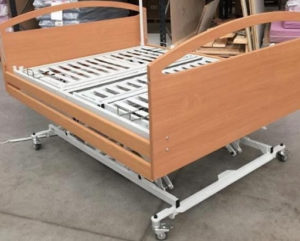


Male Plus Size (Bariatric) Service user:
Age: 34 years.
Height: 170 cm (5-7”) tall.
Weight: 362KG approx. (57 stone).
Body shape: is a combination of Pear Abducted and Apple Pannus.
Presentation: an immobile complex Plus Size (Bariatric) service user, he has lymphoedema and extensive oedema over hip area resulting in very large overhang at each side of his body at hip level. Girth Measurement Approx.120cm (48”).
Medical history: Lymphoedema, bed bound due to Medical Condition.
A joint assessment was completed at the request of the Lead Manual Handling Advisor
The CCG Requested support for this service user from Equipment Provider. A complete package of equipment was delivered consisting of:
The service user repeatedly damaged the equipment and in refusing to allow the mattress to be professionally cleaned wrote off 3 mattresses and an additional cover, this was not without significant cost to the CCG. In addition to damaged mattresses, he damaged several parts of beds he was being supported on, again not without significant cost to the CCG.
At the time of assessment, the service user was non-compliant, aggressive with staff, manipulative and threatening in his behaviour toward them.
On occasion he had tools delivered i.e., screw drivers which he secreted in his body segments hiding them from staff, it is believed this is how he ripped one of the mattresses he had been provided with.
On the first occasion equipment provider was informed that the patient remains challenging, ordering tools such as screw drivers, knives, and scissors offline which he hides either under himself or between his skin folds – which prevents staff from confiscating them until they find one, he forgets about. He refused to be searched for these kinds of items.
He was also informed that the service user was catheterised although he cut the tube and refused re-application.
The staff commented that the mattress cover is that discoloured beneath him that it has turned black.
Because of this equipment provider were not prepared to allow any further mattresses to be delivered without agreement that the service user would allow the staff to lift him off the bed, so they could clean the mattress as needed.

Situation at the time of assessment:
At the time of the visit the service user was sat up in a semi recumbent position. His head rest was at an angle of approx. 30 degrees, he was conformant was able to demonstrate a good range of movement in his upper body, he can reach over with both arms and was able to bend both of his legs when requested, although this is limited.
Due to his weight distribution, it was difficult for him to roll onto his side without assistance. The service user has the support of between 6-8 carer staff for personal care and moving and handling activities.
At the time of the visit, it was identified that the centre pieces of the bed frame had been inserted to enable staff to get closer to the patient when carrying out personal care. However, due to the patient’s weight distribution it was then difficult for staff to re-extend the deck of the bed frame and properly support the service user at hip level. This was causing an overhang at each side of the bed of the service users’ hips.
There was an Ultra Twin Free-Span Standard Gantry system erected above the patient the system was squeezed between two curtain rails although two bed spaces are available, it was not raised to its maximum height even though there is sufficient ceiling height to do so. A small Reposition sheet was in situ but is too small for the task required.
As a result, staff are working in a confined space, limiting their ability to position themselves and adopt good biomechanical principles for safe patient handling without the risk of potential injury to themselves.
The task was to laterally move the service user onto a bariatric scale bed system, safe patient working load of 400kg approx. 60 stone and aa low air loss turning mattress, safe working load of 451kg approx. 71 stone.
This low air loss system should provide microclimate management and alternative turning options reducing the need for staff intervention. This system will facilitate greater variation in positioning thereby ensuring that the service user has his pressure points regularly moved, improving skin integrity, and reducing the risk of further skin damage.
The actual technique and equipment to be used have been identified following a dynamic risk assessment the needs of the service user, environment, and any other associated risk factors. These have been communicated to the Manager in charge and lead Manual Handling Advisor.
Issues Identified to be looked at:
To consider:
Plan of action:
Technique:
A discussion took place to assess that the equipment proposed to be used and handling techniques presented were suitable.
The plan is to laterally transfer the service user onto a new bed surface placed alongside the current system.
This would be facilitated using an Ultra Stretch Lifting system fitted to an Ultra Twist Wide Free-Span Gantry.
This system would be erected in replacement of the old system and fully raised thereby utilising both bed spaces provided.
The Lead Manual Handling Advisor arranged for the removal of part of the curtain rail to enable this.
Lifting the service user on his current Repo sheet and placing onto a New Ultra Repo sheet.
(Large) on the receiving Bariatric bed, fitted with the Low Air Loss Turning Mattress.
A practical training session of this equipment would be delivered by equipment provider to the team involved prior to the transfer.
Further consideration was discussed for supporting the service user when turned with REPO sheet, to support his back and assist staff, using a CJ Medical Q2 Roller, this is being investigated as an option to aid staff to facilitate safe patient handling and personal care.
Equipment Provider to consider the legal implications of supporting the service user, if he refuses, what are the clinical implications for him and the company.
No activity should be undertaken without the full consent of the service user. This was explained to the service user including the possibility that the equipment may have to be removed if he refuses to conform to requests made by the team supporting him.
Choosing the right equipment is important this bed system was required to enable this service user to be moved on and begin his journey out of Hospital.

5ft Wide Bed Provided by Apex Care
Completed by:
John Humphray
Manual Handling Trainer, Bariatric Handling Specialist
